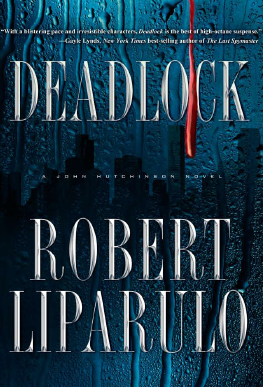
Robert Liparulo is a former journalist with over a thousand articles and multiple writing awards to his name. Readers of his action-thrillers were not surprised when his visual storytelling style caught the eye of Hollywood producers. Currently, all three of his novels for adults are in various stages of development for the big screen: the film rights to Comes a Horseman were purchased by the producer of Tom Clancy’s movies; and Liparulo is penning the screenplays for Germ and Deadfall for two top producers. He is also working with the director Andrew Davis (The Fugitive, Holes) on a political thriller. Novelist Michael Palmer calls Deadfall “a brilliantly crafted thriller.” Liparulo’s young adult series, Dreamhouse Kings, debuted in May 2008, with House of Dark Shadows and Watcher in the Woods. The third installment, Gatekeepers, was just released. March 2009 will see the publication of Deadfall’s follow-up Deadlock. He lives with his family in Monument. |
|
Fighting Bad Guys with Jack and Hutch |
|
|
I have a friend named Jack. We get together only about once a year, but when we do, man, we have fun. We’ve saved a woman from her abusive, murderous husband; beat a murder rap ourselves when we tried to find out who killed Jack’s brother; and rescued an FBI agent from the clutches of a drug lord. Sometimes, rarely, our adventures are more mundane, like when we hung out in Key West, digging pools and bouncing drunks out of a bar.
Lee’s creation is so popular that at one three-day convention of thriller writers and readers (called ThrillerFest), everyone addressed Lee Child as “Jack” or more frequently, “Reacher.” The adoration culminated in a mock trial, at which Lee played Reacher defending himself against murder charges (I played a bailiff). A group of rabid fans tried to break Lee/Reacher out of jail and make off with him. Recurring characters are particularly common in thriller fiction (romance, too, but I’m less versed in that genre): James Patterson’s Alex Cross, Jeffery Dever’s Lincoln Rhyme, Jonathan Kellerman’s Alex Delaware . . . the list is long. The attraction for readers is obvious: If someone is cool and exciting, we want to spend more time with him (or her) and experience more of his adventures. With each novel, we understand him better, and over time, we become friends with him. For writers, recurring characters mean delving deeper into the lives of fictional people with whom they lived for probably the better part of a year and who touched their hearts. Bringing back a character can also help pacing, since the bones of the guy’s development has already been established and what’s left is putting on the flesh, which is best done through the things he does, the action of the story. Some authors, however, shy away from recurring characters. Most of Stephen King’s novels are standalones (a notable exception are the Dark Tower books, which really constitute a series more than mere recurring character stories), as are Dean Koontz’s stories (his exception is Odd Thomas). I think the concern here is not with their inability to find characters they like enough to revisit, but with the fear of being saddled with someone book after book—the author’s version of being typecast. While I enjoy reading recurring character stories, I have always been wary of writing them, but for different reasons. First, I’ve never wanted to give my reader a heads-up about who’s going to survive. In each of my novels, at least one main character has met a bitter end, resulting in countless letters saying, “I can’t believe you killed off so-and-so!” Most readers, though, claim to like the twist, precisely for the reason it happened: It meant anything goes—be prepared for the unexpected because that’s the way life is. It adds to the fun, knowing the stakes are high—as they must be in thrillers—and the author’s not shy about playing that hand. |
I also tend to outline loosely, preferring to let the characters and the action dictate the direction of the story. If my protagonist had to live, I’d feel as though my storytelling hands were tied. That doesn’t mean I look for ways to kill them, but you can bet the villains sure are. And just like you and me, the characters don’t know what the outcome will be—so the readers had better not know either. Which brings us to the main reason I’ve avoided recurring characters. Good stories feel real. Even in fantastical stories, readers yearn for a connection to reality, which can come in the form of an environment that’s true to life or characters who mirror the human condition. When I’ve read recurring character stories and contemplated writing them, I’ve thought, “What is the likelihood of one person running into so much adventure and intrigue over and over?” That’s why most recurring characters are cops, private investigators, criminal psychologists—people whose professions can force them into perilous situations time and again. But even the most gung-ho cops in the most criminally active cities will tell you the chance of stumbling into an adventure as intense as most thriller stories once in a career is slim—let alone many times. So . . . no recurring characters for me, thank you. Until now. Deadlock, releasing in March, is my first venture into the world of recurring characters (not counting the Dreamhouse Kings young adult books, which is a true series). Despite popular opinion, it’s not a sequel to Deadfall. But it does feature Deadfall’s quick-thinking, laser-dodging, bow-and-arrow-wielding John Hutchinson—“Hutch” to everyone not employed by the government. It’s interesting that Deadfall was the first novel I’d written that started not with a story idea, but with a character I wanted to know better. Based on my best friend, who’s a game warden in Wyoming and one heck of a good guy, Hutch was someone whose wit, integrity, and survival skills demanded scrutiny under the severest circumstances. From that sprang the story of Deadfall and the bad-guy character of Declan Page, his cadre of misguided video-gaming cronies, and a satellite laser weapon.
I admit that going on another adventure with Hutch was a blast. I still won’t promise that he doesn’t get himself into a situation he can’t get out of, but I do hope readers find in him the kind of friend that I have in Jack Reacher. Who knows, maybe someone will one day try to spring me from jail. |
|
|
|
|
|
|









